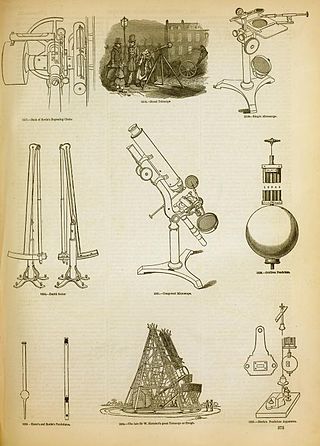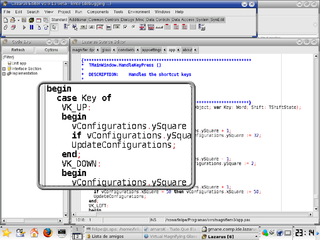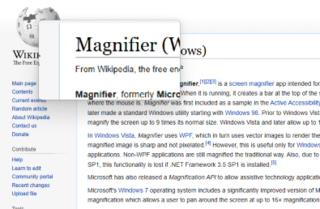
A screen magnifier is software that interfaces with a computer's graphical output to present enlarged screen content. By enlarging part of a screen, people with visual impairments can better see words and images. This type of assistive technology is useful for people with some functional vision; people with visual impairments and little or no functional vision usually use a screen reader.

Magnification is the process of enlarging the apparent size, not physical size, of something. This enlargement is quantified by a size ratio called optical magnification. When this number is less than one, it refers to a reduction in size, sometimes called de-magnification.

A magnifying glass is a convex lens that is used to produce a magnified image of an object. The lens is usually mounted in a frame with a handle. A magnifying glass can be used to focus light, such as to concentrate the sun's radiation to create a hot spot at the focus for fire starting.

An optical instrument is a device that processes light waves, either to enhance an image for viewing or to analyze and determine their characteristic properties. Common examples include periscopes, microscopes, telescopes, and cameras.

A sight or sighting device is any device used to assist in precise visual alignment of ranged weapons, surveying instruments, aircraft equipment or optical illumination equipments with the intended target. Sights can be a simple set or system of physical markers that serve as visual references for directly aligning the user's line of sight with the target, or optical instruments that provide an optically enhanced — often magnified — target image aligned in the same focus with an aiming point. There are also sights that actively project an illuminated point of aim onto the target itself so it can be observed by anyone with a direct view, such as laser sights and infrared illuminators on some night vision devices, as well as augmented or even virtual reality-enabled digital cameras with software algorithms that produce digitally enhanced target images.
ZoomText is a screen magnifier for Microsoft Windows developed by Ai Squared which was acquired by Freedom Scientific in 2016. The first version was released for DOS in 1988, and the first version for Windows was released in 1991. ZoomText is available in two editions: ZoomText Magnifier and ZoomText Magnifier/Reader, which includes a built-in screen reader.

A dome magnifier is a dome-shaped magnifying device made of glass or acrylic plastic, used to enlarge words on a page or computer screen. They are plano-convex lenses: the flat (planar) surface is placed on the object to be magnified, and the convex (dome) surface provides the enlargement. They usually provide between 1.8× and 6× magnification. Dome magnifiers are often used by the visually impaired. They are good for reading maps or basic text and their inherent 180° design naturally amplifies illumination from ambient side-light. They are suitable for people with tremors or impaired motor skills, because they are held in contact with the page during use.

Virtual Magnifying Glass is an open-source, screen magnification tool for Microsoft Windows and Linux.

A curved mirror is a mirror with a curved reflecting surface. The surface may be either convex or concave. Most curved mirrors have surfaces that are shaped like part of a sphere, but other shapes are sometimes used in optical devices. The most common non-spherical type are parabolic reflectors, found in optical devices such as reflecting telescopes that need to image distant objects, since spherical mirror systems, like spherical lenses, suffer from spherical aberration. Distorting mirrors are used for entertainment. They have convex and concave regions that produce deliberately distorted images. They also provide highly magnified or highly diminished (smaller) images when the object is placed at certain distances.
Shape moiré is one type of moiré patterns demonstrating the phenomenon of moiré magnification. 1D shape moiré is the particular simplified case of 2D shape moiré. One-dimensional patterns may appear when superimposing an opaque layer containing tiny horizontal transparent lines on top of a layer containing a complex shape which is periodically repeating along the vertical axis.

Video magnifiers are electronic devices that use a camera and a display screen to perform digital magnification of printed materials. The display screen is usually LCD or a similar flat-screen technology, and the device usually includes a lamp to illuminate the source material. Video magnifiers are designed to be mostly used by people with low vision that cannot be helped using a conventional magnifying glass.

ThunderHawk is a discontinued web browser from Bitstream available for a full range of operating systems in high end and mass-market mobile phones and personal digital assistants. It is basically meant for mobile operators and original equipment manufacturers and not meant to download for normal users.

Magnifier, formerly Microsoft Magnifier, is a screen magnifier app intended for visually impaired people to use when running Microsoft Windows. When it is running, it creates a bar at the top of the screen that greatly magnifies where the mouse is. Magnifier was first included as a sample in the Active Accessibility SDK/RDK for Windows 95 and later made a standard Windows utility starting with Windows 98. Prior to Windows Vista, Magnifier could be used to magnify the screen up to 9 times its normal size. Windows Vista and later allow up to 16× magnification.

An optical comparator or profile projector is a device that applies the principles of optics to the inspection of manufactured parts. In a comparator, the magnified silhouette of a part is projected upon the screen, and the dimensions and geometry of the part are measured against prescribed limits. It is a useful item in a small parts machine shop or production line for the quality control inspection team.
Telesensory Systems, Inc. (TSI) was an American corporation that invented, designed, manufactured, and distributed technological aids for blind and low vision persons. TSI's products helped visually impaired people work independently with computers and with ordinary printed materials.

The BOLT Browser was a web browsing system for mobile phones including feature phones and smartphones able to run Java ME applications. The BOLT browser was installed on the phone, and BOLT servers accessed Web pages, processed and compressed them, and delivered them to phones running the browser. The BOLT Browser was offered free of charge to consumers, and by license to mobile network operators and handset manufacturers. BOLT was produced by Bitstream Inc., the company which previously produced ThunderHawk for mobile network operators and handset manufacturers. BOLT was originally introduced into private beta on January 15, 2009 and was made available to the public on February 16, 2009 when the public beta was announced at Mobile World Congress in Barcelona. BOLT supported Java-based handsets with Java MIDP 2 and CLDC 1.0 or higher. BOLT also has specially optimized version for BlackBerry smartphones and worked with Windows Mobile and Palm OS devices that employ a MIDlet manager or Java emulator. BOLT was built using the WebKit rendering engine to display a full Web page layout as found on desktop web browsers.

A tower viewer is a telescope or pair of binoculars permanently mounted on a stalk. The device magnifies objects seen through its lenses, allowing users to see farther and more clearly than they could with the naked eye or with less powerful viewing devices. Tower viewers are typically metallic and most swivel horizontally and vertically to permit a range of view. The viewing machines are commonly placed in tourist destinations and scenic lookouts for the purpose of viewing attractions and events of interest; they are also used in residential, business, recreational and government locations for the purposes of surveillance and safety monitoring.

Haiku is a free and open-source operating system compatible with the now discontinued BeOS.

Android 12 is the twelfth major release and 19th version of Android, the mobile operating system developed by the Open Handset Alliance led by Google. The first beta was released on May 18, 2021. Android 12 was released publicly on October 4, 2021, through Android Open Source Project (AOSP) and was released to supported Google Pixel devices on October 19, 2021.

A sight magnifier is an optical telescope that can be paired with a non-magnifying optical sight on a weapon to create a telescopic sight. They work with the parallel collimated reticle image produced by red dot sights and holographic weapon sights. They may synonymously be referred to as a red dot magnifier, reflex sight magnifier, holographic sight magnifier, or flip to side magnifiers.















